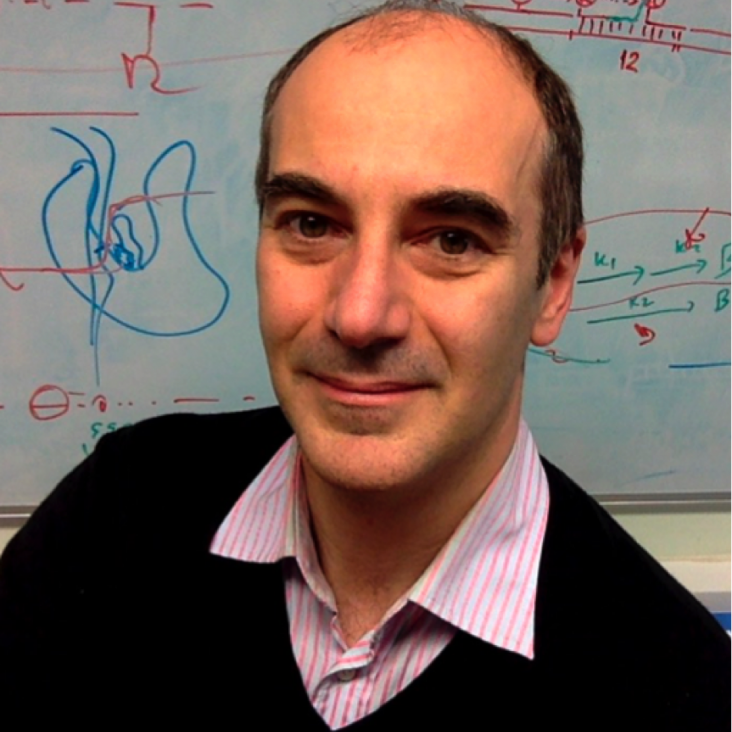High-throughput single-virion DNA-PAINT reveals structural diversity, cooperativity, and flexibility during selective packaging in influenza
Nucleic Acids Research Oxford University Press 53:19 (2025) gkaf1020
Abstract:
Influenza A, a negative-sense RNA virus, has a genome that consists of eight single-stranded RNA segments. Influenza co-infections can result in reassortant viruses that contain gene segments from multiple strains, causing pandemic outbreaks with severe consequences for human health. The outcome of reassortment is likely influenced by a selective sequence-specific genome packaging mechanism. To uncover the contributions of individual segment pairings to selective packaging, we set out to statistically analyse packaging defects and inter-segment distances in individual A/Puerto Rico/8/34 (H1N1) (PR8) virus particles. To enable such analysis, we developed a multiplexed DNA-PAINT approach capable of assessing the segment stoichiometry of >10 000 individual virus particles in one experiment; our approach can also spatially resolve the individual segments inside complete virus particles with a localization precision of ∼10 nm. Our results show the influenza genome can be assembled through multiple pathways in a redundant and cooperative process guided by preferentially interacting segment pairs and aided by synergistic effects that enhance genome assembly, driving it to completion. Our structural evidence indicates that the interaction strength of segment pairs affects the spatial configuration of the gene segments, which appears to be preserved in mature virions. As our method quantified the interactions of whole influenza segments instead of identifying individual sequence-based interactions, our results can serve as a template to quantify the contributions of individual sequence motifs to selective packaging.The displacement of the σ70 finger in initial transcription is highly heterogeneous and promoter-dependent
Nucleic Acids Research Oxford University Press 53:17 (2025) gkaf857
Abstract:
Most bacterial sigma factors (σ) contain a highly conserved structural module, the 'σ-finger', which forms a loop that protrudes towards the RNA polymerase active centre in the open complex and has been implicated in pre-organization of template DNA, abortive initiation of short RNAs, initiation pausing, and promoter escape. Here, we introduce a novel single-molecule FRET (smFRET) assay to monitor σ-finger motions during transcription initiation and promoter escape. By performing real-time smFRET measurements, we determine that for all promoters studied, displacement occurs before promoter escape and can occur either before or after a clash with the extending RNA. We show that the kinetics of σ-finger displacement are highly dependent on the promoter, with implications for transcription kinetics and regulation. Analogous mechanisms may operate in the similar modules present across all kingdoms of life.Pointwise prediction of protein diffusive properties using machine learning
JPhys: Photonics IOP Publishing 7:3 (2025) 035025
Abstract:
The understanding of cellular mechanisms benefits substantially from accurate determination of protein diffusive properties. Prior work in this field primarily focuses on traditional methods, such as mean square displacements, for calculation of protein diffusion coefficients and biological states. This proves difficult and error-prone for proteins undergoing heterogeneous behaviour, particularly in complex environments, limiting the exploration of new biological behaviours. The importance of determining protein diffusion coefficients, anomalous exponents, and biological behaviours led to the Anomalous Diffusion Challenge 2024, exploring machine learning methods to infer these variables in heterogeneous trajectories with time-dependent changepoints. In response to the challenge, we present M3, a machine learning method for pointwise inference of diffusive coefficients, anomalous exponents, and states along noisy heterogenous protein trajectories. M3 makes use of long short-term memory cells to achieve small mean absolute errors for the diffusion coefficient and anomalous exponent alongside high state accuracies (>90%). Subsequently, we implement changepoint detection to determine timepoints at which protein behaviour changes. M3 removes the need for expert fine-tuning required in most conventional statistical methods while being computationally inexpensive to train. The model finished in the Top 5 of the Anomalous Diffusive Challenge 2024, with small improvements made since challenge closure.Tunable fluorogenic DNA probes drive fast and high-resolution single-molecule fluorescence imaging
Nucleic Acids Research Oxford University Press 53:13 (2025) gkaf593
Abstract:
A main limitation of single-molecule fluorescence (SMF) measurements is the 'high concentration barrier', describing the maximum concentration of fluorescent species tolerable for sufficient signal-to-noise ratio. To address this barrier in several SMF applications, we design fluorogenic probes based on short single-stranded DNAs, fluorescing only upon hybridizing to their complementary target sequence. We engineer the quenching efficiency and fluorescence enhancement upon duplex formation through screening several fluorophore-quencher combinations, label lengths, and sequence motifs, which we utilize as tuning screws to adapt our labels to different experimental designs. Using these fluorogenic probes, we can perform SMF experiments at concentrations of 10 μM fluorescent labels; this concentration is 100-fold higher than the operational limit for standard TIRF experiments. We demonstrate the ease of implementing these probes into existing protocols by performing super-resolution imaging with DNA-PAINT, employing a fluorogenic 6-nt-long imager; through the faster acquisition of binding events, the imaging of viral genome segments could be sped up significantly to achieve extraction of 20-nm structural features with only ∼150 s of imaging. The exceptional tunability of our probe design will overcome concentration barriers in SMF experiments and unlock new possibilities in super-resolution imaging, molecular tracking, and single-molecule fluorescence energy transfer (smFRET).Single-molecule imaging for unraveling the functional diversity of 10–23 DNAzymes
Analytical Chemistry American Chemical Society 97:25 (2025) 13300-13309


